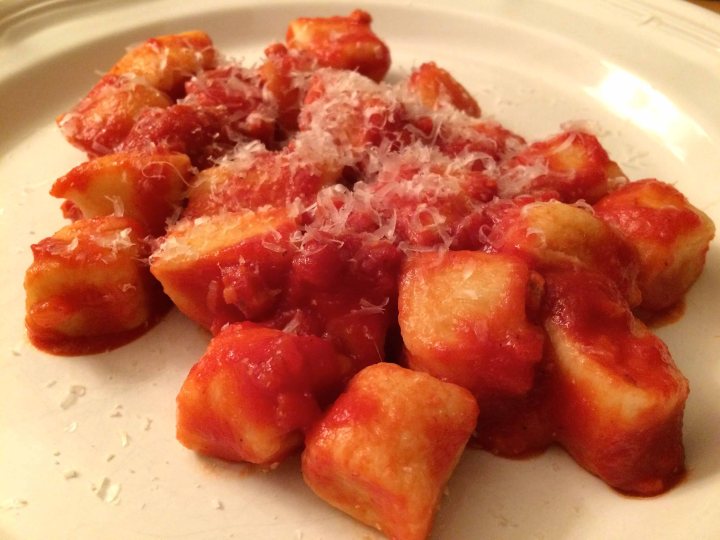Whenever I approach my pasta board to make gnocchi, the Apollo 13 quote “Failure is not an option” comes to mind. But all too often, when faced with a dough that just won’t come together or with gnocchi as heavy as rocks, I tell myself “If at first you don’t succeed…” In my quest for perfect gnocchi, I’ve read endless recipes, watched numerous videos, and most recently attended a cooking class (a recent Valentine’s gift—was my better half hinting?)
I must admit that I have had some successful attempts, a few with potato gnocchi and some with those made with flour and water. And perhaps these successes were what motivated me to attempt ricotta gnocchi once again last night.
From my failures, I’ve learned that the key to pillow light gnocchi of any variety is using the minimum amount of flour. Too much flour will weigh down the gnocchi. For this reason, any recipe you use must yield to how the dough feels to your hand as you add the flour to the wet or moist ingredients. In the case of ricotta gnocchi, these are ricotta and egg.
The recipe I used called for 1 1/4 cups of flour for two cups of whole-milk ricotta and 2 large eggs. The instructions suggested using a rubber spatula to blend in the flour in three parts. After adding the first third of the flour, however, I started to use my hands and bench scraper to work in the flour.
After the second third of the flour, the dough started to come together, so I went slowly with the last third, being careful to use a light touch and not overwork the dough. When i added the final third the dough was still a little moist. But rather than adding any more flour directly to the dough, I dusted my board with some bench flour and lightly rolled my ball of dough over it until the dough no longer felt sticky but was still soft and light.
Next comes cutting the ball of dough into quarters and rolling each quarter into a dowel or log that’s 5/8 inch in diameter. Here it’s important that your board is scraped clean and dusted only lightly with bench flour. Your hands also need to be clean—free of any dough. Also use the palms of your hands as opposed to your fingertips to roll out even logs of dough.

I like my gnocchi on the smaller side so I cut each log into 1/2 to 5/8-inch pieces.
I line a sheet pan with parchment paper and dust it with semolina flour to hold the cut gnocchi. The semolina keeps the cut pieces from sticking to each other.
Cooking is fast and simple. I use a squat 8-quart pot with heavily salted boiling water. Gently slide the gnocchi into the boiling water and cook for about 2 minutes, by which time they should have risen to the top. Using a spider or slotted spoon, I transfer the cooked gnocchi to a skillet with the heated sauce and gently toss.

For the sauce, I used a variation on that included with the recipe, substituting a passata for the whole plum tomatoes and omitting the garlic.
To sum up, when it comes to making gnocchi, you need to rely on your hands to feel the dough to judge the optimum ratio of dry to wet, when you’ve used no more flour than is necessary to form the perfect dough. I guess ending on one more adage won’t hurt: practice makes perfect.
